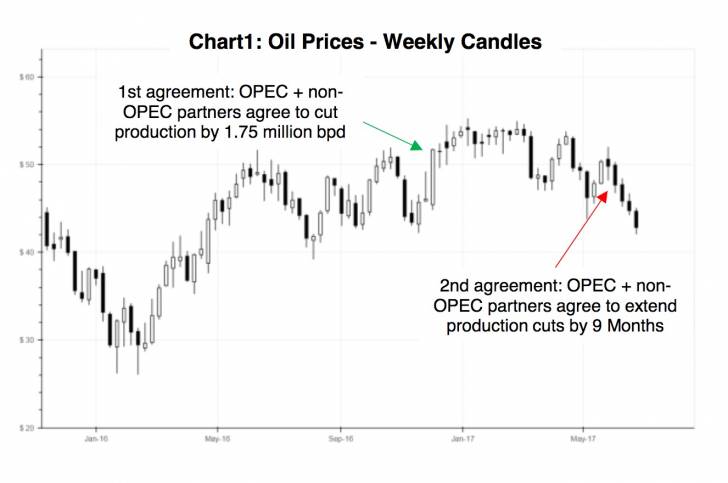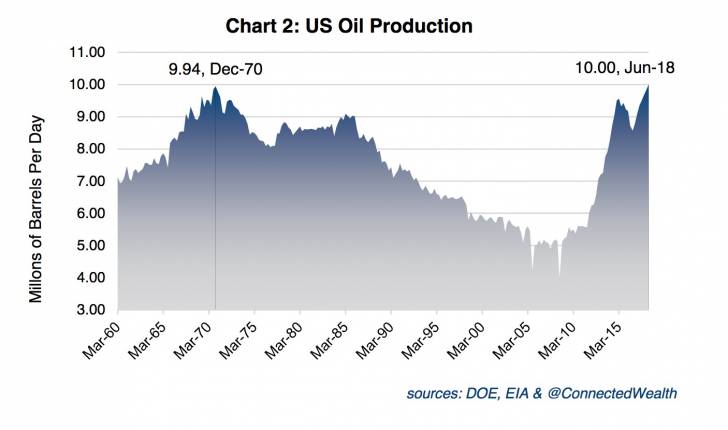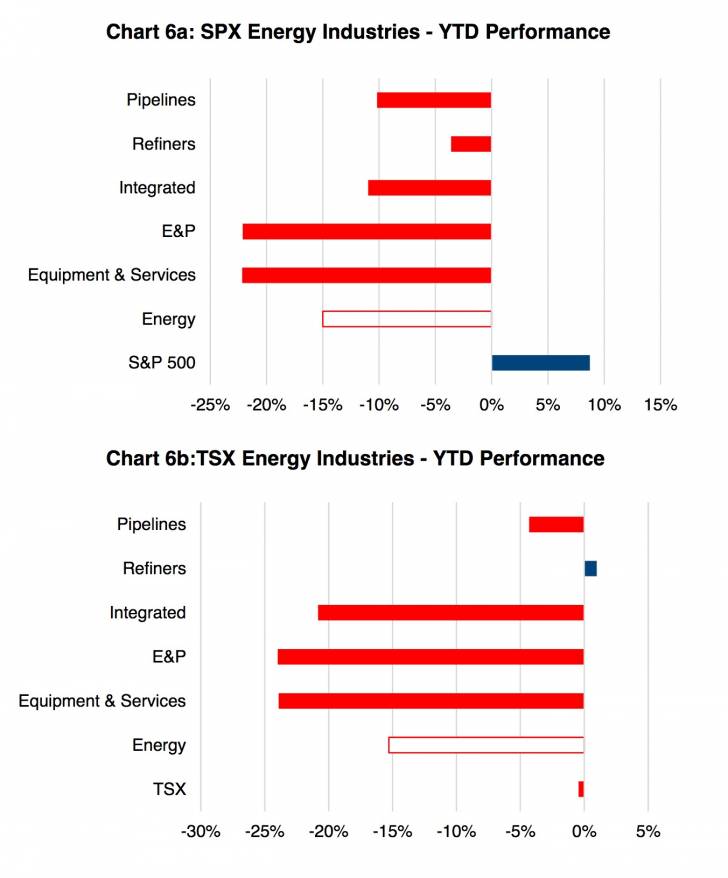MARKET ETHOS: Oil In Purgatory
by Shane Obata, CFA and Chris Kerlow, CFA, RichardsonGMP
In the 1st half of 2014, the outlook for oil was bright. Prices were rising, companies were investing and free cash flow was gushing. The good times were expected to last; on June 30th, 2014, the average analyst forecast for oil prices (West Texas Intermediate) was to remain above $92 through 2017.
 Unbeknownst to most, the world was on the verge of an epic battle among oil producers who sought to increase production and market share. Supply was rising faster than demand and people were starting to worry about a ballooning oil inventories. Saudi Arabia, haunted by its past mistakes and determined to maintain market share, chose not to cut production to address the glut and instead continued to pump. The goal being to push higher cost shale production out of the market. These developments led to a massive slide in oil prices, which fell from over $100 in the 1st half of 2014 to a low of $26.05 on February 12th, 2016; the point of maximum pessimism. Subsequently, oil rebounded as sentiment improved. U.S. production began falling and some investors hoped that OPEC would intervene. That is exactly what they got in November 2016, when OPEC agreed to curtail production. The agreement pushed WTI above $50 a barrel, where it held until March this year. Optimism was back in the market that rebalancing was on the way, OPEC was helping and supply would fall below demand, to help address the global glut in oil inventories.
Unbeknownst to most, the world was on the verge of an epic battle among oil producers who sought to increase production and market share. Supply was rising faster than demand and people were starting to worry about a ballooning oil inventories. Saudi Arabia, haunted by its past mistakes and determined to maintain market share, chose not to cut production to address the glut and instead continued to pump. The goal being to push higher cost shale production out of the market. These developments led to a massive slide in oil prices, which fell from over $100 in the 1st half of 2014 to a low of $26.05 on February 12th, 2016; the point of maximum pessimism. Subsequently, oil rebounded as sentiment improved. U.S. production began falling and some investors hoped that OPEC would intervene. That is exactly what they got in November 2016, when OPEC agreed to curtail production. The agreement pushed WTI above $50 a barrel, where it held until March this year. Optimism was back in the market that rebalancing was on the way, OPEC was helping and supply would fall below demand, to help address the global glut in oil inventories.
Recently this optimism began to fade. U.S. production was rising again and there were concerns that OPEC members who were exempt from the production quota might offset Saudi Arabia’s best efforts. Rebalancing has been moving farther away and sentiment has been worsening. On May 25th, OPEC and non-OPEC members agreed to extend production cuts for nine months. Unfortunately, that was not enough for the market (Chart 1). As we write, oil has fallen to $43.18. That is 22% lower than the high of $55.25 on January 3rd, 2017. Prices have fallen back into a bear market and we are concerned about more downside. Still, our recommendation is the same as it was on January 30th, stay underweight energy and focus on defensive names.
Supply
 In May, OPEC and its non-OPEC partners showed record compliance with the deal to cut production. Reuters’ data shows that OPEC compliance, driven largely by Saudi Arabia, was 108%. In other words, the group reduced production by more than it initially agreed to. Non-OPEC (Russia, Mexico, etc.) compliance was 100%. Even so, that may not be enough. Iraq has only achieved a 55% compliance rate this year while Venezuela & the UAE have been less than perfect. Countries such as Nigeria and Libya, which are exempt from the deal, have been increasing production.
In May, OPEC and its non-OPEC partners showed record compliance with the deal to cut production. Reuters’ data shows that OPEC compliance, driven largely by Saudi Arabia, was 108%. In other words, the group reduced production by more than it initially agreed to. Non-OPEC (Russia, Mexico, etc.) compliance was 100%. Even so, that may not be enough. Iraq has only achieved a 55% compliance rate this year while Venezuela & the UAE have been less than perfect. Countries such as Nigeria and Libya, which are exempt from the deal, have been increasing production.
U.S. output has also been growing. It rose to 9.35 million barrels per day (bpd) in the week ended June 16th, 2017. Moreover, the EIA now expects that U.S. production could reach 10 million bpd in 2018, eclipsing the previous record of 9.94 million bpd which was set back in December of 1970 (Chart 2). The shale revival has been driven by efficiency.
 Technological improvements have allowed U.S. companies to raise output at lower costs. As a result, many wells that were not previously economically viable are now, even with oil around $50. According to the Dallas Fed, the average prices needed to cover operating expenses at existing wells range from $24 to $38. In other words, many existing wells are at least breaking even at today’s prices.
Technological improvements have allowed U.S. companies to raise output at lower costs. As a result, many wells that were not previously economically viable are now, even with oil around $50. According to the Dallas Fed, the average prices needed to cover operating expenses at existing wells range from $24 to $38. In other words, many existing wells are at least breaking even at today’s prices.
The same does not apply for new wells, which break even from $46 to $55 (Chart 3). If oil stays at current levels or falls below then drilling activity will probably slow down. That said, with better operating margins and lower cost structures, it is likely that production will be more resilient than it was last time around.
 U.S. inventories have been falling since the end of March. That is supportive; however, they remain well above 5-year averages. In addition, the typical pattern is for inventories to peak in late April / early May and then draw down into the fall. This year, the draw started earlier, which is partially attributable to record refinery throughput (Chart 4). On a bigger scale, OECD inventories have actually grown 360,000 bpd in 2017. They now stand at 250 million barrels above their 5-year average. Non-OECD stocks and floating storage fell in the 1st quarter of 2017; however, the latter is now rising.
U.S. inventories have been falling since the end of March. That is supportive; however, they remain well above 5-year averages. In addition, the typical pattern is for inventories to peak in late April / early May and then draw down into the fall. This year, the draw started earlier, which is partially attributable to record refinery throughput (Chart 4). On a bigger scale, OECD inventories have actually grown 360,000 bpd in 2017. They now stand at 250 million barrels above their 5-year average. Non-OECD stocks and floating storage fell in the 1st quarter of 2017; however, the latter is now rising.
The one wild card is Saudi Arabia. The kingdom wants to diversify its economy by investing in non-oil sectors. Unfortunately, the downturn in oil prices has left Saudi Arabia cash-strapped. In order to achieve its goals, Saudi Arabia needs its crown jewel, Saudi Aramco, to have a successful IPO. Aramco’s valuation is highly dependent on oil prices. Thus, it is reasonable to assume that the kingdom will do whatever it takes to support them.
At present, Saudi Arabia is cutting ~600 thousand bpd. In the 1980s, the kingdom curtailed production by more than 6.7 million bpd. Although improbable, a further reduction in output is not out of the question. If that did occur then rebalancing would be pulled forward, sentiment would improve and prices could skyrocket.
Demand
 The supply-side of the market has deteriorated but the demand-side has not. Global oil demand is expected to rise by 1.3% in 2017. That is positive; however, we would note that 1.3% would be deceleration relative to the 1.7% and 2.1% seen in 2016 and 2015, respectively.
The supply-side of the market has deteriorated but the demand-side has not. Global oil demand is expected to rise by 1.3% in 2017. That is positive; however, we would note that 1.3% would be deceleration relative to the 1.7% and 2.1% seen in 2016 and 2015, respectively.
The OECD will account for ~48% of global oil demand in 2017. We are positive on Europe and Japan. Therefore, we would not be surprised if OECD growth figures come in better than expected. Even so, it is important to note that non-OECD is the major growth driver. Non-OECD Asia, which includes China and India, will account for 75% of global growth in 2017, according to the International Energy Agency (IEA). We are not overtly concerned that China which appears to be seeing some softening. Still, we acknowledge that there is the potential for a slowdown. China injected a massive amount of credit into its economy in 2015/early 2016. That helped to reinvigorate investment and to support commodity prices. Now, the credit impulse is starting to wane.
 Moreover, there are concerns about refinery cuts and fewer imports relative to the 1st half of 2017. Each of these developments has the potential to weigh on demand. India recently took its two largest bank notes out of circulation. The resulting cash shortage has negatively impacted oil demand. Despite that, we believe that strong GDP in 2017 will continue to boost demand growth, albeit at a slower pace than in 2016.
Moreover, there are concerns about refinery cuts and fewer imports relative to the 1st half of 2017. Each of these developments has the potential to weigh on demand. India recently took its two largest bank notes out of circulation. The resulting cash shortage has negatively impacted oil demand. Despite that, we believe that strong GDP in 2017 will continue to boost demand growth, albeit at a slower pace than in 2016.
Markets
The energy markets have been fading for some time. Year to date, crude is down ~20% while U.S. (XLE) and Canadian (XEG) energy stocks have underperformed their respective indices by ~21% and ~22%, respectively (Chart 5). Despite weakness at the sector level, there has been some dispersion at the industry level. Refiners & Pipelines have outperformed while E&P & Equipment & Services have underperformed the sectors (Chart 6). On the credit side, high yield energy is finally starting to show signs of weakness. M&A activity is also drying up. Activity among U.S. E&Ps fell to <$15 billion in Q2 of 2017 vs. $23 billion in Q1. Of the former amount, $6.7 billion is attributable to the deal between EQT Corp and Rice Energy. In terms of volume, the number of deals has fallen to the lowest level since early 2015. The same applies to Canada, where major players such as Royal Dutch Shell, Marathon and ConocoPhillips have been paring back investment.
Implications
The outlook for oil has worsened and rebalancing has been pushed further away. Reuters’ John Kemp recently stated that “oil traders have become increasingly doubtful that OPEC will manage to cut (inventories) stocks down to the 5-year average and keep them there.” That is a far cry from the optimism that we witnessed not long ago. While our macro view is tilted to the negative side, we are not in the business of buying and selling oil. Our focus is on defensive companies that will continue to perform even if the downside risks to come to fruition. The portfolios are underweight energy, with an emphasis on low-beta names such as TransCanada and Suncor. Our view is that it is impossible to time the bottom. As a result, we are adding to positions and will continue to do so if and when prices move lower.
“The petroleum industry has not of late years earned a return on its investment sufficient to enable it to continue to carry in the future the burden and responsibilities placed upon it in the public’s interest, and it would seem impossible to do so unless present conditions are changed.” – Anglo-Persian Oil Company (now BP) – 18 August 1928
Charts are sourced to Bloomberg unless otherwise noted. This material is provided for general information and is not to be construed as an offer or solicitation for the sale or purchase of securities mentioned herein. Past performance may not be repeated. Every effort has been made to compile this material from reliable sources however no warranty can be made as to its accuracy or completeness. Before acting on any of the above, please seek individual financial advice based on your personal circumstances. However, neither the author nor Richardson GMP Limited makes any representation or warranty, expressed or implied, in respect thereof, or takes any responsibility for any errors or omissions which may be contained herein or accepts any liability whatsoever for any loss arising from any use or reliance on this report or its contents. Richardson GMP Limited is a member of Canadian Investor Protection Fund. Richardson is a trade-mark of James Richardson & Sons, Limited. GMP is a registered trade-mark of GMP Securities L.P. Both used under license by Richardson GMP Limited.
Copyright © RichardsonGMP














